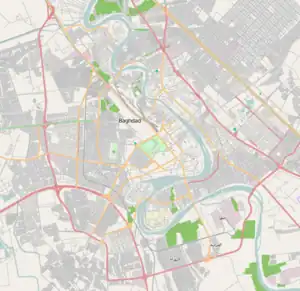Syed Sultan Ali Mosque
Syed Sultan Ali Mosque (Arabic: جامع سيد سلطان علي) is an ancient mosque in Baghdad, Iraq. It is among the cultural heritages of the city, located at the southern part of the historical area of Rusafa at al-Rasheed Street, near the al-Ahrar bridge, adjacent to the Tigris river.[1] The mosque was first established in 1590, under the rule of Ali Pasha. The name of the mosque is derived from the Syed Sultan Ali who is buried in it.
| Syed Sultan Ali Mosque | |
|---|---|
Arabic: جامع سيد سلطان علي | |
 Syed Sultan Ali Mosque in 1918 | |
| Religion | |
| Affiliation | Islam |
| Ecclesiastical or organisational status | Mosque and shrine |
| Status | Active |
| Location | |
| Location | Al-Rasheed Street, Rusafa, Baghdad, Iraq |
 Location in Baghdad, Iraq | |
| Geographic coordinates | 33°19′57″N 44°23′54″E |
| Architecture | |
| Type | Mosque |
| Style | Ottoman architecture |
| Date established | 1590 CE |
| Specifications | |
| Capacity | 1,000 worshipers |
| Interior area | 600 square metres (6,500 sq ft) |
| Minaret(s) | 1 |
| Site area | 1,000 square metres (11,000 sq ft) |
| Shrine(s) | 1 |
In 2001, the mosque was restored and it's development was ordered by former-Iraqi President Saddam Hussein.[2]
Construction
The mosque contains a madrasa, where some well known ulamas such as sheikh Ahmad Shakes al-Alusi had taught. It was restored in 1873 which expanded the area size to 1,000 square metres (11,000 sq ft). It also has tekyeh known as Tekyeh Quratun Ali. The mosque is attached by the minaret built of bricks, taking the shape of the Ottoman architectural style and decorated with blue tiles. The haram reaches 600 square metres (6,500 sq ft) and can accommodate 1,000 worshipers. The haram has old mihrab and minbar, with the inscriptions of the Qur'anic verses over the wall.[3]
On the left side in the mosque is the shrine and mausoleum of Said Sultan Ali, whose identity remains unsolved, with some people identifying him as the father of Ahmad al-Rifa`i, the founder of the Rifa`i tariqa. However, the Iraqi historian Muhammad Bahja al-Athari considers him as the a descendant of Imam Jafar al-Sadiq, Sultan Ali ibn Ismail ibn Jafar, and finds the former theory as a fabrication. Another revered saint, Imam Al-Rawas is buried next to Sultan Ali.
On the righthand side exists the entrance to the madrasa, and the tomb of Khatun bint Darush Jalabi. On the center exists the entrance to the corridor of the mosque.[4]
References
- الدليل السياحي للأضرحة والمقامات في العراق - دائرة الأضرحة والمقامات والمراقد السنية العامة - ديوان الوقف السني في العراق. p.38
- "أمانة بغداد تستعد لإعادة شارع الرشيد لمكانته التاريخية". www.aljazeera.net (in Arabic). Retrieved 2023-08-17.
- دليل الجوامع والمساجد التراثية والأثرية - ديوان الوقف السني في العراق. p.36.
- جامع السيد سلطان علي. Al-Zawra. Retrieved January 27, 2018.
